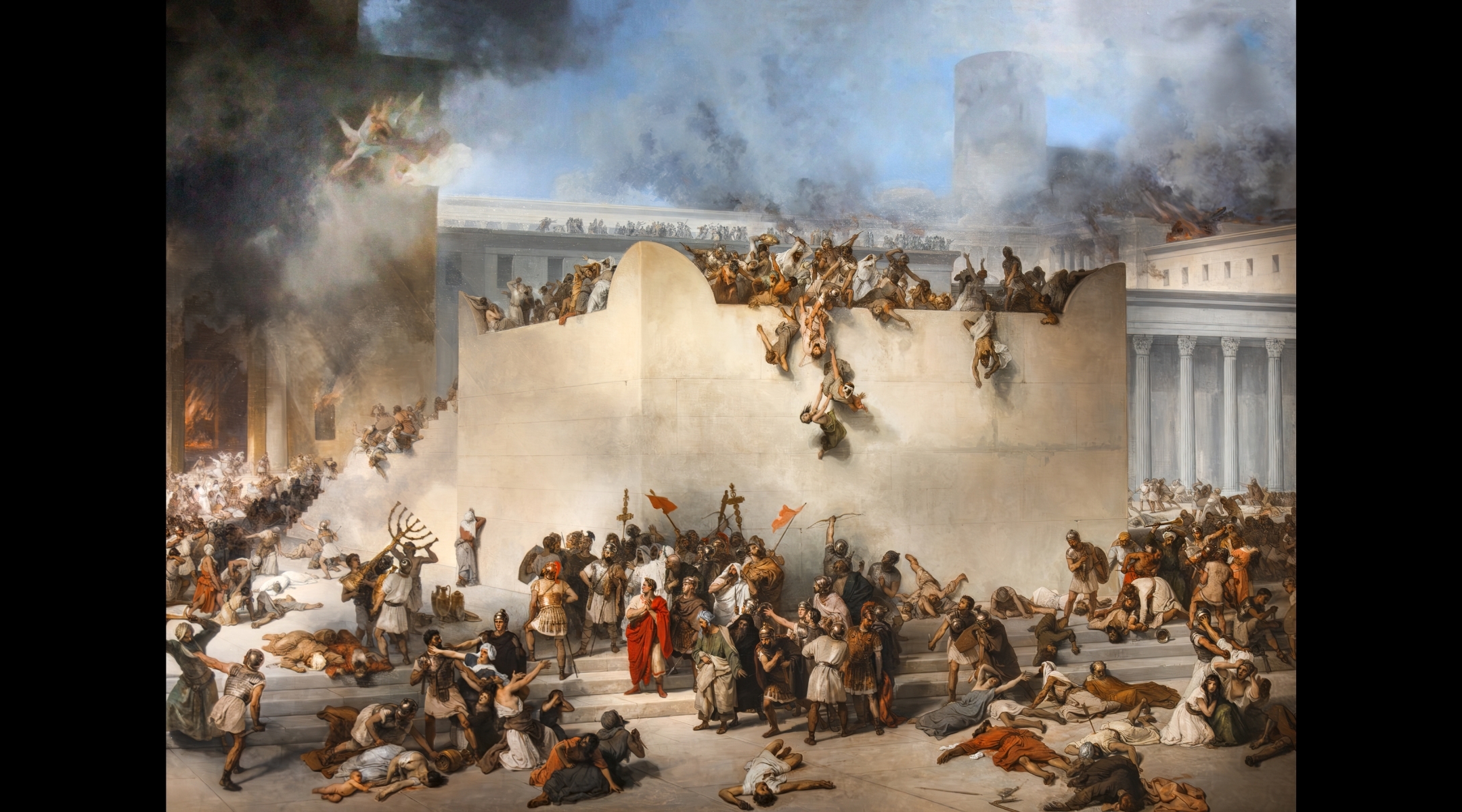In first Tisha B’Av after Oct. 7, Jewish writers, musicians, and lay leaders compose new liturgy and traditions to mourn a fresh tragedy
New liturgy and rituals connect the traditional meaning of Tisha B’Av — which begins Monday night at sundown — and current anguish

Francesco Hayez’s masterpiece, ‘Destruction of the Temple of Jerusalem’. (Wikimedia)
(JTA) — When Israeli musician Yagel Haroush set out to write a mournful song about the destruction of Kibbutz Be’eri on Oct. 7, he described it as both a therapeutic exercise and an attempt to grapple with a gruesome reality.
He was also tapping into an ancient and timely tradition. Every year, on the fast day of Tisha B’Av, Jewish communities worldwide chant a series of dirges, called “kinnot,” that commemorate the tragedies of Jewish history in verse, from the destruction of the temples to the Crusades to the Holocaust.
Haroush’s song, called “Kinat Be’eri,” aims to be the latest addition to that collection. It memorializes the destruction of Be’eri through verses that evoke the Book of Lamentations, read on Tisha B’Av night. The opening lines, “How did Be’eri / turn into my tomb / The day of my light / to the day of my gloom,” lead to more graphic descriptions of that day’s carnage.
“First, one needs to articulate the pain,” Haroush wrote in notes compiled by the Israeli rabbinic organization Tzohar. “One gives it words, which hurt unto the point of tears. Second, one requests, through the pain, hoping to see, through tear-filled eyes, the comfort and life that surround us.”
Haroush’s kina is one of many ways Jewish communities plan to use Tisha B’Av, which begins Monday evening, to commemorate the tragedy of Oct. 7 and its aftermath. Tisha B’Av, which principally mourns the destruction of the ancient Holy Temples in Jerusalem, also serves as a day of mourning for millennia of Jewish tragedies — many of which occurred on or near the day itself. Now, congregations, rabbis, scholars and musicians are responding to Oct. 7 and the war against Hamas in Gaza with liturgy and rituals that draw a connection between the fast day and the anguish of the present.
“It’s like there is a structure that is built into Tisha B’Av to create this container for grief,” said Rabbi Avi Strausberg, senior director of national learning initiatives at the egalitarian Hadar Institute. “I feel like sometimes we have to work hard to find the personal relevance to Tisha B’Av,” she added, but “this Tisha B’Av, I think, is just a wholly different experience.”
Haroush is one of a few Israelis who have turned to writing kinnot to grieve the losses of Oct. 7. Another kina by Nurit Hirschfeld-Skupinsky, a professor of midrash in Israel who is from Kibbutz Nahal Oz, another site of the attack, begins with the same words as Lamentations: “O How She Sat Alone.”
In Hirschfeld-Skupinsky’s dirge, the Oct. 7 massacres at the nearby Kibbutz Nir Oz and the city of Sderot replace references to Jerusalem in the original text for the destruction of Jerusalem and the First Temple. The final stanza references the ongoing suffering of the “120 men, women, elders and children” being held hostage in Gaza.
“Crying, they are crying at night / Tears on their cheeks,” the dirge concludes. “And there is no one who comforts.”
Hirschfield-Skupinsky has also written midrashim, or interpretive texts, about Oct. 7 that play on the Hebrew word “bayit,” which means house or home, but can also refer to the two holy temples commemorated on Tisha B’Av.
“That’s part of what’s captured in Nurit’s midrashim, that is, the destruction of the Temple and the destruction of these houses,” said Strausberg. “And it’s the same word, ‘bayit.’ It’s as if the destruction of the Temple — we don’t have to manufacture some experience to connect to some tragedy that occurred thousands of years ago. The tragedy is happening right now, and those houses are being destroyed right now.”
Some are taking Tisha B’Av as an opportunity to mourn Palestinian suffering as well. The Halachic Left, a new group of observant Jews who oppose Israel’s war in Gaza, has co-created a Tisha B’Av reader that annotates the text of Lamentations with accounts from Palestinians in Gaza.
“We placed these texts side-by-side to draw attention to the unimaginable violence and suffering Israel, backed by the United States and other countries around the world, has inflicted on the people of Gaza, as well as those throughout Palestine, and the eerie, awful similarity between these events and those recorded in our canonical text,” reads the introduction to the reader, which was also created by the group All That’s Left and includes essays by Jewish writers. “The fact that the most mythic, foundational violence and trauma in Jewish memory has been inflicted upon others in the name of Jewish safety is unimaginable.”
The Halachic Left will also hold a public, silent vigil in a yet-to-be-disclosed New York City neighborhood, centering primarily on the suffering Palestinians over the past 10 months, and also grieving the loss of Israeli lives on Oct. 7. Participants in the Halachic Left demonstration will have their mouths duct-taped shut, and they will attend the vigil in shifts.
“For us, it’s impossible to read the text of Eicha without also thinking about Gaza,” said Eliana Padwa, one of the group’s organizers, using the Hebrew name for Lamentations. Padwa said the group is trying to emphasize that traditional Tisha B’Av practices are “not contradictory to caring about Palestinians, but they actually go hand-in-hand.”
Padwa acknowledged that many pro-Israel Jews bristle at those who question the toll of of what they consider a just war in Gaza. “We’re going to do this vigil in a place where we’ll be extremely visible to the religious community, which is nerve wracking for a lot of us,” she said.
Though much of Tisha B’Av is concerned with grief, traditionally the latter part of the day is meant to take a more uplifting tone. So although he wrote a mournful song about Oct. 7, Haroush also hopes his dirge, like others, will portend a day when no more like it need be written.
“There’s something in the pain that gets to the deepest part of you, to the thing on which your existence rests,” Haroush said in a video posted to his Instagram page. “I think the ultimate purpose of the kina is comfort.”














